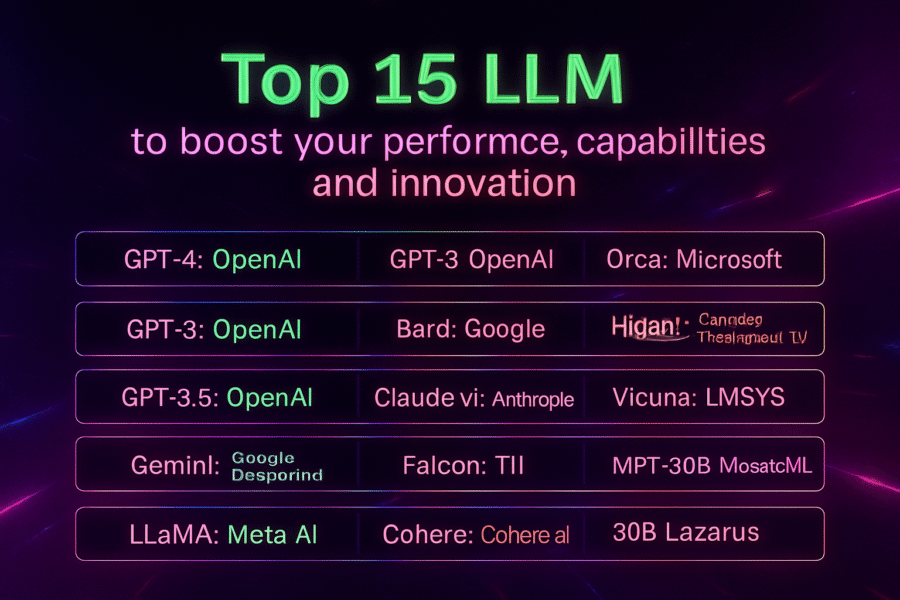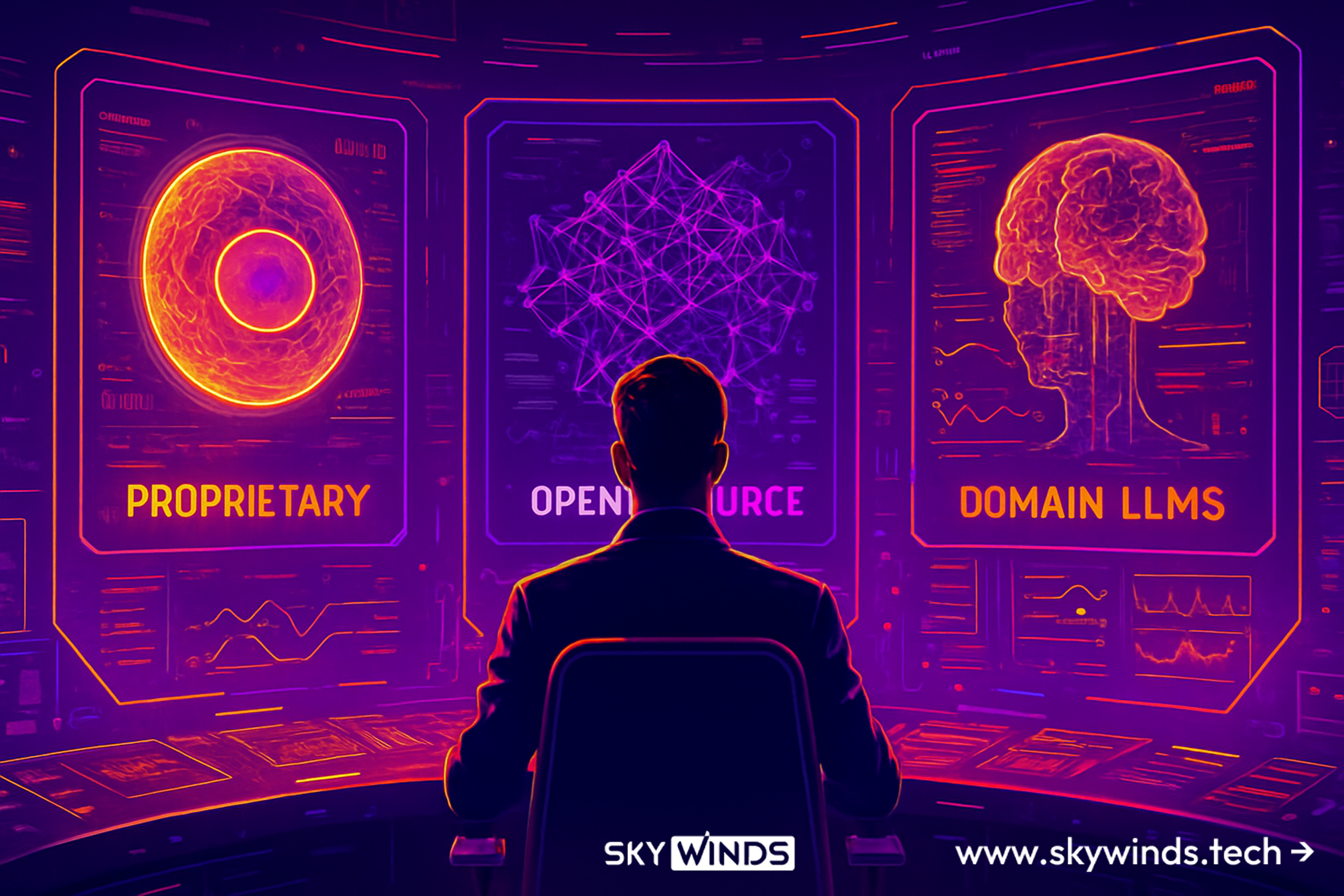Table of Contents
- Introduction
- Understanding LLM Fundamentals
- The LLM Model Categories Explained
- The Complete Selection Framework
- 15 Leading LLM Models That Are Transforming Business Applications
- 1. GPT‑4.1 (OpenAI)
- 2. Claude 4 Opus (Anthropic)
- 3. Claude 4 Sonnet (Anthropic)
- 4. Gemini 2.5 Pro (Google)
- 5. Grok 4 (xAI)
- 6. Nova Premier (Amazon Web Services)
- 7. Llama 4 Scout (Meta AI)
- 8. DeepSeek R1‑0528 (DeepSeek)
- 9. Qwen3‑235B‑A22B‑Thinking (Alibaba)
- 10. MiniMax‑Text‑01 (MiniMax)
- 11. Llama Nemotron Ultra (NVIDIA)
- 12. Mistral Medium 3 (Mistral AI)
- 13. Solar Pro 2 (Upstage AI)
- 14. Kimi K2 (Moonshot AI)
- 15. Grok 4 Heavy (xAI variant)
- Implementation Strategy & Best Practices
- Future-Proofing Your LLM Strategy
- Conclusion & Action Steps
- FAQs
Introduction
In 2025, AI isn’t just a buzzword — it’s business-critical. According to industry surveys, over 67% of organizations have implemented AI tools, with 88% reporting improvements in work quality. Yet for founders, CTOs, and enterprise leaders exploring large language models (LLMs), the challenge isn’t adoption — it’s selection.
With 100+ commercial and open-source LLMs now available, the sheer volume of options leads to decision paralysis. Some promise unmatched accuracy. Others tout data privacy or open weights. And then there are multimodal models, fine-tuned assistants, and domain-specific engines… all claiming to be “the best.”
That’s where this guide comes in.
You’re about to get a complete, business-focused breakdown of the LLM landscape. From fundamentals to model types, from pricing strategies to integration checklists — this post is designed to help you choose the right model for your unique needs.
Whether you’re deploying your first proof-of-concept or evaluating enterprise-grade tools for scaled automation, this resource will help you move forward with clarity.
The future of software is LLM-native. Are you ready to lead — or risk falling behind?
At Skywinds, we don’t just build AI features. We architect scalable, secure, LLM-powered solutions tailored to your business goals.
Join the SaaS founders and CTOs across the US, Canada, and Europe who are already shipping faster with Skywinds.
Understanding LLM Fundamentals
1. What Are Large Language Models?
Large Language Models (LLMs) are neural networks trained on massive volumes of text data to understand and generate human-like language. At their core, these models predict the next word in a sentence — but the magic lies in how they do it at scale.
Most LLMs are built on Transformer architecture, a breakthrough in deep learning that uses attention mechanisms to weigh the relevance of each word in a sentence, regardless of its position. This is what allows LLMs to generate coherent paragraphs, answer complex questions, and even write functional code.
Training these models involves ingesting gigabytes to terabytes of text — books, articles, codebases, forum posts, and more. The model learns statistical patterns in language, which it then uses to generate responses, translate languages, summarize text, or simulate conversation.
2. Why LLMs Matter for Business
LLMs are not just academic marvels — they’re reshaping business operations globally. From automating customer support, to generating marketing content, to accelerating code development, these models are unlocking new levels of productivity.
- Automation: LLMs power chatbots, content generators, documentation tools, and coding assistants.
- Competitive Edge: Always-on availability, near-zero marginal cost, and speed of execution make LLMs a strategic differentiator.
- ROI-Driven: Businesses adopting LLMs report cost reductions, increased output, and improved customer experience.
3. Current Market Landscape
Leaders like OpenAI, Anthropic, Google DeepMind, Meta, and Mistral AI are pushing the frontier — each offering models with unique capabilities, trade-offs, and ideal use cases.
The LLM market is projected to reach $82.1 billion by 2033, up from just $6.4 billion in 2024. And adoption is accelerating: 88% of professionals say LLMs have improved their work quality.

The LLM Model Categories Explained
Choosing the right LLM starts with understanding the types available — because not all models are built for the same purpose. Here’s a breakdown of the three dominant categories, plus a look at fine-tuning considerations.
1. Proprietary / Closed-Source Models
These are the power players of the LLM world — typically developed by well-funded companies with advanced infrastructure and large training datasets.
Leading Models: GPT‑4.1 (OpenAI), Claude 4 (Anthropic), Gemini 2.5 Pro (Google), Nova Premier (AWS), Grok 4 (xAI)
Advantages:
- Consistently high performance on reasoning, generation, and coding tasks
- Enterprise-grade uptime and support
- Rapid improvements and updates
Disadvantages: - Higher cost (often usage-based billing)
- Limited transparency into training data
- Risk of vendor lock-in
Best For: Customer-facing tools, productized AI features, natural language interfaces
2. Open-Source Models
These models are released with accessible weights and codebases, offering greater control and customizability — especially useful for companies with in-house ML teams.
Top Models: Explore Llama 3.1 (Meta), Mistral 7B, Code Llama, Qwen, DeepSeek on Hugging Face.
Advantages:
- Freedom to fine-tune, deploy privately, or integrate deeply
- Lower or no per-token cost
- No dependency on third-party APIs
Disadvantages: - Requires ML expertise to deploy and manage
- Community support can be inconsistent
Best For: Internal tooling, startups prioritizing cost, regulated industries (e.g. finance, healthcare)
3. Specialized Models
Some LLMs are purpose-built for niche applications or industries — and when used correctly, they outperform general-purpose models in their domain.
Subtypes Include:
- Code Generation – GitHub Copilot, StarCoder, CodeT5
- Industry-Specific – Med-PaLM (medical), LexNLP (legal), BloombergGPT (finance)
- Multimodal Models – GPT‑4 Vision, Gemini, Claude (text + images)
When to Choose:
- You need deep domain fluency (legal, medical, financial)
- Your product uses multiple inputs (images, voice, documents)
- You’re building autonomous agents with task-specific logic
4. Pre-Trained vs. Fine-Tuned
Every LLM starts as a pre-trained model — trained broadly across the internet. But for businesses, fine-tuning on proprietary data can offer sharper results.
Pre-Trained Models: Ready to use out of the box, great for general tasks
Fine-Tuned Models: Require effort but deliver tailored accuracy, brand voice alignment, and regulatory compliance
Key Considerations:
- Data quality and volume
- Engineering resources
- Hosting and compute costs
The Complete Selection Framework
LLM success isn’t just about picking the most powerful model — it’s about aligning with your business needs, technical constraints, and use cases. This framework helps founders and CTOs cut through the hype and make data-driven decisions.
1. Business Requirements Assessment
Start by outlining what success looks like. Here are the dimensions that matter:
Performance Criteria
- Accuracy Needs: Are mistakes tolerable, or is precision critical (e.g. legal, financial)?
- Speed Requirements: Is near-instant response time required (e.g. chat), or is delay acceptable (e.g. batch summarization)?
- Scale Demands: Will you handle hundreds or millions of queries per day?
Technical Constraints
- Integration Complexity: Does the model offer SDKs, REST APIs, clear docs?
- Infrastructure Requirements: Will you use cloud APIs, self-hosted models, or hybrid deployment?
- Security Standards: Must it meet GDPR, HIPAA, SOC 2, or ISO 27001 compliance?
Map these requirements against model specs to eliminate misaligned options early.
2. Cost Analysis Framework
LLMs vary wildly in pricing models and hidden costs. Here’s how to budget smartly:
Direct Costs
- Usage-Based Pricing: Most APIs charge per 1K tokens — costs add up fast at scale
- Subscription Models: Some offer flat rates for high-volume access
- Infrastructure Costs: Self-hosting? Account for compute, memory, storage, and bandwidth
Hidden Costs
- Development Time: Open models need more integration and testing
- Maintenance Overhead: Ongoing updates, monitoring, and troubleshooting
- Training Requirements: Onboarding your team and building internal expertise
Don’t just compare token prices — model total cost of ownership (TCO) over 6–12 months.
3. Use Case Matching Matrix
Not all LLMs are good at everything. Match your top use cases to model strengths:
Content Generation
- Marketing Copy: Creativity, tone control, brand voice
- Technical Docs: Accuracy, consistency, terminology fluency
- Customer Comms: Clarity, personalization, multilingual output
Analytical Tasks
- Data Processing: JSON parsing, table generation, trend summarization
- Research Help: Citation inclusion, hallucination reduction
- Decision Support: Structured reasoning, low bias, verifiability
Automation Workflows
- Customer Service: Intent detection, context memory, escalation triggers
- Internal Ops: Slack bots, report automation, data entry
- Developer Support: Code explanation, generation, test writing
Assign model benchmarks to each task to determine fit.
4. Vendor Evaluation Criteria
Found a model that fits? Vet the vendor next:
- Support Quality: Is there 24/7 help? What’s their SLA? Is documentation developer-friendly?
- Roadmap Transparency: Do they share product direction or deprecate features suddenly?
- Reliability Metrics: Check uptime history, latency benchmarks, and real-world performance reports
Bonus: Explore active community engagement, plugin ecosystems, and third-party audit reports.
15 Leading LLM Models That Are Transforming Business Applications
1. GPT‑4.1 (OpenAI)
Released in April 2025, GPT‑4.1 is OpenAI’s most refined flagship model, offering up to 1M token context across Mini, Nano, and standard variants. It delivers strong improvements in coding, instruction‑following, and long‑document comprehension—scoring ~55% on SWE‑bench, outperforming GPT‑4o. GPT‑4.1 is ideal for general-purpose tasks, legal documentation, and code-heavy workflows
2. Claude 4 Opus (Anthropic)
Claude Opus 4 (and the 4.1 upgrade in August 2025) leads on SWE‑bench with ~72.5% accuracy and sustained autonomous performance over multi-hour coding or agentic workflows. It supports extended reasoning, long-term memory, and structured output—perfect for engineering-heavy or tool-driven SaaS deployments.
3. Claude 4 Sonnet (Anthropic)
Sonnet 4 offers near-Opus-level capabilities—including tool-use reasoning, parallel execution, and a 200K-token context window—at a lower cost tier. It’s a strong compromise for business applications requiring robust reasoning without premium pricing.
4. Gemini 2.5 Pro (Google)
This multimodal model excels at reasoning and creative tasks, scoring highly on Humanity’s Last Exam and SWE‑bench (~63.8%). With support for text, image, audio, and code, it’s especially effective if your teams already rely on Google Cloud or Workspace integration.
5. Grok 4 (xAI)
Grok 4 claims to be the “most intelligent model” with integrated real-time search, tool use, and strong reasoning benchmarks—even outperforming prior flagship systems in tasks like Humanity’s Last Exam (up to 44% for Heavy). However, recent controversies around its “Imagine” video feature raise compliance considerations for enterprise use
6. Nova Premier (Amazon Web Services)
Nova Premier is AWS’s top multimodal model tuned for complex, multi-step reasoning—capable of processing text, images, and video. It’s positioned as AWS’s premium solution, also suitable as a teacher model for building distilled, cost-efficient custom models.
7. Llama 4 Scout (Meta AI)
Scout is Meta’s open-weight MoE (mixture-of-experts) model with 17B parameters and natively multimodal capability. It supports long context windows (up to 10M tokens), multimodal inputs, and efficient deployment on a single H100 GPU. Ideal for cost-conscious enterprise deployments needing scale and performance.
8. DeepSeek R1‑0528 (DeepSeek)
An open-source reasoning-focused model with 671B total parameters (37B active per inference). R1‑0528 is optimized for benchmark accuracy and coherence, supports JSON output and function calling, and comes at no usage cost—ideal for teams building high-volume internal tools within regulated industries.
9. Qwen3‑235B‑A22B‑Thinking (Alibaba)
Qwen3-235B-A22B-Thinking balances scale and efficiency using MoE architecture with 22B active parameters. It delivers fast inference rates (1,400 tokens/sec), long-context handling, and low compute costs—alignment that makes it a strong fit for enterprise-grade chat, reasoning, and translation workflows .
10. MiniMax‑Text‑01 (MiniMax)
A small- to mid-size specialized open-source text LLM (MiniMax), optimized for lower compute environments. While benchmarks are limited, it appeals to organizations needing basic natural language abilities with minimal infrastructure—especially for content pipelines in localized regions.
11. Llama Nemotron Ultra (NVIDIA)
Built on the Llama 4 architecture, Nemotron Ultra includes NVIDIA’s optimizations for inference speed and fine-tuning. While academic literature is limited, it’s targeted toward organizations leveraging NVIDIA tech stacks that require efficient deployments across cloud and edge environments.
12. Mistral Medium 3 (Mistral AI)
As a lightweight yet enterprise-ready model from Mistral, Medium 3 emphasizes efficiency and fine-tuning adaptability. It is suited for startups or teams with smaller compute budgets wanting custom-tuned open-source base models.
13. Solar Pro 2 (Upstage AI)
An emerging specialized industrial LLM focused on enterprise-grade reasoning, Solar Pro 2 supports tool-connected workflows and improved safety filters. It’s tailored to regulated sectors in Europe and Asia.
14. Kimi K2 (Moonshot AI)
An agent‑ready multimodal assistant LLM built for task orchestration, Kimi K2 supports voice, image, code, and structured data. Designed for pro‑data-product teams, especially in automation-heavy enterprises.
15. Grok 4 Heavy (xAI variant)
A more powerful variant of Grok 4 optimized for complex agentic reasoning, reaching ~44% on Humanity’s Last Exam. Priced at ~$300/month, it suits businesses that need maximum intelligence and tool-chain autonomy, provided you can manage risk and compliance concerns

Implementation Strategy & Best Practices
Launching an LLM successfully requires more than choosing the right model — it’s about thoughtful execution.
1. Start with a Pilot
Pick a focused use case: automated helpdesk replies, code suggestions, or meeting summarization.
Define KPIs (e.g. accuracy, latency, user feedback) and keep timelines tight: 30–60 days for proof of value.
2. Integrate Smart
Use well-documented APIs. Add rate limiting, caching, and fallback logic.
Ensure data encryption, access control, and audit logging from day one.
3. Scale with Control
Monitor usage, costs, and performance metrics.
Use abstraction layers so you can switch models without breaking your system.
Train teams early — prompt design and feedback loops drive ROI.
4. Avoid Common Traps
Don’t over-engineer. Don’t skip testing.
And don’t get locked into a single vendor without a plan B.
Future-Proofing Your LLM Strategy
The LLM landscape is evolving fast — what works today may be obsolete tomorrow. Building with agility and foresight is the only sustainable strategy.
1. Emerging Trends to Watch
- Multimodal Integration: Models like Gemini and GPT-4 Vision now process text, images, audio, and even video in one pipeline — enabling richer, more humanlike interactions.
- Edge Deployment: As compliance and latency become more critical, edge-friendly models let you run AI closer to your users — protecting privacy and reducing infrastructure costs.
- Agent-Based Systems: LLMs are shifting from passive responders to active agents — capable of taking actions, using tools, and orchestrating full workflows autonomously.
2. Strategic Recommendations
- Flexible Architecture: Build with API abstraction layers that let you swap models without major rewrites.
- Continuous Evaluation: Reassess models quarterly — competitors, costs, and capabilities change fast.
- Innovation Investment: Dedicate budget and talent to explore new models, fine-tuning methods, and emerging use cases — before your competitors do.

Conclusion & Action Steps
The LLM space in 2025 is both crowded and confusing — but it doesn’t have to be. With the right framework, clear use cases, and a solid understanding of what each model offers, you can deploy AI that drives real business value.
Key takeaways:
- Align model choice with business needs, not hype
- Use open-source when control matters, proprietary when performance counts
- Always test, measure, and stay flexible
Next Steps
- Assess your top use cases — customer service, dev tools, marketing, etc.
- Match them to model categories using the framework above
- Pilot your first LLM project within 30–60 days
Need expert guidance or a full implementation team? Skywinds partners with SaaS leaders and product teams across North America and Europe to build secure, scalable LLM-powered software.
Let’s architect your next AI milestone.
skywinds.tech
FAQs
1. What is an LLM model and how does it work?
An LLM (Large Language Model) is an AI system trained on massive text data to understand and generate human-like language. It uses transformer architecture to predict and produce coherent responses.
2. Which LLM model is best for my business?
It depends on your needs. Use GPT‑4.1 or Claude for general tasks, Gemini for multimodal use, and open-source models like Llama for budget or compliance-focused deployments.
3. How much does it cost to run an LLM model?
Costs vary by provider and usage. API-based models charge per token, while open-source models require infrastructure for hosting but offer long-term savings.
4. Can I fine-tune an LLM with my own data?
Yes. Fine-tuning lets you customize a model for specific tasks or industries. You’ll need quality data, ML expertise, and the right infrastructure.
5. What are common mistakes when implementing LLMs?
Top mistakes include using overly complex models, skipping testing, ignoring security, and relying too heavily on one vendor without backup options.




